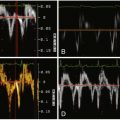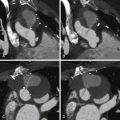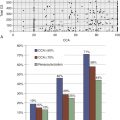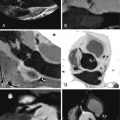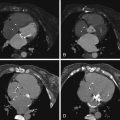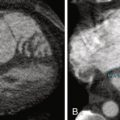Key Points
- ▪
Cardiac CT scans may encounter a wide spectrum of noncoronary/noncardiac lesions, in both the chest and upper abdomen, of widely ranging clinical relevance.
- ▪
The incidence of noncoronary/noncardiac findings is significant.
- ▪
Review of the study by a radiologist is necessary, therefore, to ensure accurate reporting of noncoronary lesions and so that an appropriate management plan can be instituted.
- ▪
Systematic scrutiny of noncardiac structures can offer alternative causes for the patient’s symptoms.
- ▪
The notion that cardiac CT scanning provides a measure of noncardiac “screening” should be discouraged, because the entire chest is not imaged and the detection of noncardiac lesions by electron beam CT or coronary CT angiography is more a matter of chance than design.
Detection of Incidental Noncoronary Cardiac and Extracardiac Lesions
Coronary CT angiography (CTA) may encounter both significant and nonsignificant noncoronary cardiac lesions. An overview of these lesions is presented in Table 30-1 ; their treatment has been reviewed in the preceding chapters of this book. An overview of significant and nonsignificant extracardiac findings is presented in Table 30-2 ; their treatment is discussed in this chapter. The term “incidental” for the discovery of pathology that was not within the intended purview of the coronary artery examination is, of course, of cold comfort to the patient.
| Myocardium | |
| Left ventricular hyperplasia Diverticula Crypts Signs of prior infarction Regional thinning | Regional fatty metaplasia Regional calcification Mural thrombus |
| Valvular | |
| Aortic valve Bicuspid Calcification Stenosis | Mitral Annular calcification Valvular |
| Pericardial | |
| Effusion Simple Complex Thickening Infection Tumor | Calcification Trauma Infection Asbestosis Cyst |
| Congenital | |
| Patent foramen ovale Nonadherent IAS Atrial septal defect | Ventricular septal defect Ventricular septal aneurysm |
| Mediastinal | |
| Anterior | |
| Thymus Thymoma Teratoma | Lymphoma Thyroid Metastasis |
| Middle | |
| Lymphoma Infectious Tumor Sarcoid Esophageal Esophagitis Carcinoma Hiatal hernia Pericardial Effusion Thickening Calcification Tumor | Vascular: aortic dissection IMH Penetrating ulcer Aneurysm Aortitis Vascular: pulmonary arteries Embolism Aneurysm Vascular: other lesions Patent ductus arteriosus PLSVC |
| Posterior | |
| Neurogenic Aortic aneurysm Lymphadenopathy | |
| Lungs | |
| Nodules/Masses | |
| Infection Neoplasia | |
| Non-Nodular Lesions | |
| Consolidation | |
| Pneumonia Tumor | |
| Bronchiectastsis | |
| Infection Congenital | |
| Emphysema | |
| Chest Wall | |
| Bones | |
| Sclerosis (degenerative, metastatic) Fractures Destruction (metastasis, infection) | |
| Lymph Nodes | |
| Internal mammary Axillary Supraclavicular | |
| Breast Tissue | |
| Nodules/masses Calcification | |
| Soft Tissue | |
| Abscess Hematoma Tumor | |
| Pleura | |
| Effusion | |
| Simple Complex | |
| Thickening | |
| Infection Tumor | |
| Calcification | |
| Trauma Infection Asbestosis | |
| Upper Abdominal | |
| Gastrointestinal Tract | |
| Hiatus hernia Tumor | |
| Liver | |
| Cyst Nodule | |
| Adrenal | |
| Nodule | |
Cardiac-directed CT studies detect noncardiac pathology of significance or potential relevance in 5% to18% of examinations and nonsignificant noncardiac findings in 40% to 60%. The range of both these potential findings is vast, as is the potential significance of both. The high incidence of detection of noncardiac pathologies is one of the principal rationales behind having a trained radiologist read, co-read, or over-read a cardiac CT (CCT) study. The two large series that have been reported to date arose from calcium scoring by electron beam CT (EBCT) series. A recent large study retrospectively reviewing 1764 patients who had undergone CCT studies demonstrated a significant difference in the presence of incidental and clinically significant findings in patients studied for coronary artery bypass grafting and other indications for CTA compared with patients referred only for calcium scoring, with 18% of patients in the former group having extracardiac findings that required further follow-up.
All studies to date have been observational. No study has been properly structured to address the influence on outcome according to the identification of noncoronary and noncardiac lesions.
CT scans of the aorta detect an even higher percentage of noncardiac pathologies, because in those scans the abdomen also is imaged.
The term “incidental” is regrettably used to describe noncoronary/noncardiac findings: it is hard to understand what is incidental about identifying primary or metastatic malignancies of lung, esophagus, breast, or other organs; aortic aneurysms; pulmonary emboli; or other serious disorders.
Whether or not incidental detection of non-cardiac findings constitutes any real form of screening is unproven, unknown, and unlikely. Detection by CCT of noncardiac lesions fundamentally amounts to detection by accident, not methodologic screening by design. Unless the entire lung fields are included within the field of view (a far wider field of view than is standard for non–bypass graft/coronary/cardiac studies), pulmonary imaging as a part of CCT will always be incomplete, and inappropriate to categorize as a screening examination.
The detection of noncardiac lesions by EBCT or CCT remains of unproven utility in improving clinical outcomes.
Horton et al. reported on 1326 patients who had undergone EBCT (3-mm slices) and found that the incidence of noncardiac pathologies detected that required follow-up imaging or further investigation was 7.8% ( Table 30-3 ).
| PATHOLOGY | PATIENTS ( n = 1326) |
|---|---|
| Noncalcified lung nodules < 1 cm | 53 |
| Noncalcified lung nodules ≥ 1 cm | 12 |
| Infiltrates | 24 |
| Indeterminate liver lesions | 7 |
| Sclerotic bone lesions | 2 |
| Breast abnormalities | 2 |
| Polycystic liver disease | 1 |
| Esophageal thickening | 1 |
| Ascites | 1 |
Hunold et al. described a 53% incidence of accidental pathologies (2061 lesions) detected among 1812 patients who had undergone EBCT ( Table 30-4 ).
| Pathology | Prevalence (%) |
|---|---|
| Cardiac structures/pericardium Pericardial Thickening Effusion Calcification Cardiac Mitral calcification Aortic valve Left atrial thrombi Myxoma | 32 4.5 1.6 0.9 7.6 13 |
| Aortic disease Calcification Ectasia Aneurysm Type A dissection | 23 0.2 0.6 0.06 |
| Lung disease | 20 |
| Further diagnostic testing | 11 |
| Specific therapy initiated | 1.2 |
Schragin et al. reviewed 1356 EBCT scans over 2 years and established a 20.5% incidence of one or more noncardiac findings among a population with only a 13% incidence of smoking. Findings without follow-up recommendations ( n = 221) and recommendations for follow-up CTA scans are shown in Table 30-5 . There was one reported death during follow-up that included a cancer identified by EBCT; that death was attributed to renal cell carcinoma.
| Pathology | No. of Patients |
|---|---|
| Findings without follow-up recommendations ( n = 221) | |
| Pulmonary scarring | 63 |
| Granuloma | 39 |
| Emphysema/bullae | 29 |
| Nonsuspicious nodules | 28 |
| Pleural disease | 21 |
| Pulmonary fibrosis | 5 |
| Atelectasis | 8 |
| Calcified lymph nodes | 6 |
| Lung cysts | 4 |
| Bronchiectasis | 2 |
| Small infiltrate | 2 |
| Hepatomegaly | 2 |
| Dilated aorta | 1 |
| Fissure thickening | 1 |
| 57 patients were recommended to have follow-up CT scans | |
| Pulmonary nodules | 46 |
| Consolidation and infiltrations | 3 |
| Fibrosis and interstitial disease | 3 |
| Hilar adenopathy | 2 |
| Large pulmonary mass | 1 |
| Thoracic aneurysm | 1 |
| Liver mass | 1 |
Onuma et al. reviewed noncardiac findings among 503 patients who underwent 16- or 64-slice CCT and found that
- □
Noncardiac findings were detected in 58% of patients ( n = 292).
- □
A total of 346 noncardiac findings were detected in 292 patients.
- □
Significant noncardiac findings were noted in 23% of patients.
- □
Malignancies were found in 0.8% of patients ( n = 4).
As with many examples of low-pretest probability imaging, the detection of noncoronary/noncardiac findings by CCT scanning leads to repeat imaging, generally with CT scanning, thereby beginning to accrue radiation exposure and risk.
Machaalany et al. described a 1% incidence of clinically significant findings and a 7% incidence of “indeterminate” findings among a low-risk, largely outpatient (98%) population who were followed for 3 years. Over this short period of follow-up, noncardiac and cancer death did not differ between patients with and without “indeterminate findings.” Evaluation of clinically significant findings and indeterminate findings were not standardized. One death occurred secondary to an investigation of an indeterminate finding. High costs were associated with investigating indeterminate findings (US $83,000/Canadian $57,000).
The utility and appropriateness of large-field versus small-field reconstructions and over-reading is a debated topic. Compared with large-field reconstruction, small-field reconstructions lead to lower detection of possibly significant findings, and a far lower rate of subsequent investigation.
Lung Lesions
Pulmonary Nodules and Masses
Pulmonary nodules are the most common incidental finding on CCT, reported in 10% to 12% of studies ( Figs. 30-1 through 30-3 ). Important features of a pulmonary nodule to evaluate include:
- □
Size : Guidelines for follow-up for small pulmonary nodules based on size have been presented and incorporated by most radiology departments.
- □
Margin : The presence of an irregular or speculated margin should raise concern for an aggressive lesion. Small nodules associated with ground-glass densities and a “tree-in -bud” configuration are commonly seen in infectious conditions such as pneumonia and represent impaction of the bronchiolar lumen secondary to pus, mucus, or fluid.
- □
Internal characteristics : The presence of dense central calcification is more likely to reflect a nodule secondary to prior granulomatous infection. Calcified granulomas can be multiple. One rare element in the differential diagnosis for multiple calcified nodules would be metastatic disease from primaries such as osteosarcoma. “Popcorn” type calcifications, especially in association with intralesional fat, are commonly seen in hamartomas, a benign lung lesion.


